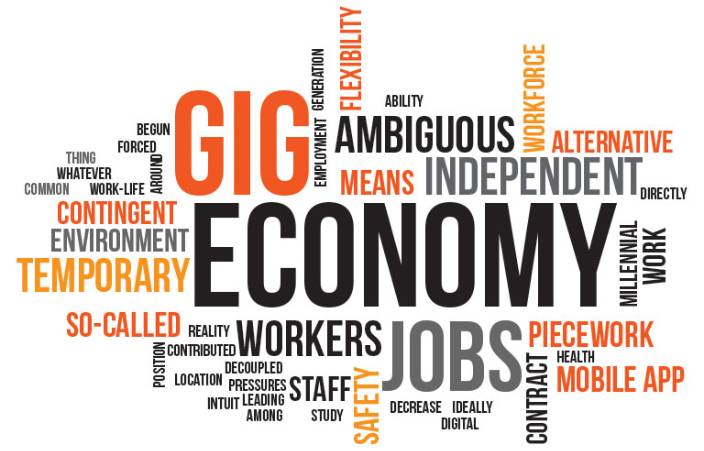News Highlights
NITI Aayog’s Study revealed that India’s Gig Economy workforce to reach 2.35 crore by 2030
Key Takeaways of the Study
- Need of Social Security
- India requires a framework that balances the flexibility offered by platforms while also ensuring social security of workers.
- Classification of Gig Workers
- The report broadly classified gig workers into platform and non platform based workers.
- While platform workers are those whose work is based on online software applications or digital platforms such as food aggregator platforms Zomato, Swiggy, Ola and others
- Non-platform gig workers are generally casual wage workers and own account workers in the conventional sectors, working part time or full time.
- The report broadly classified gig workers into platform and non platform based workers.
- New Classification of Labour Force
- The consequent platformization of work, gave rise to a new classification of labour, “platform labour”, falling outside the purview of the traditional dichotomy of formal and informal labour.”
- Rising challenges of the Sector
- Lack of job security, irregularity of wages and uncertain employment status for workers.
- Additionally, the contractual relationship between the platform owner and worker is characterised as other than one of employment.
- Platform workers are termed as “independent contractors”.
- As a result, platform workers cannot access many of the workplace protections and entitlements.
- More medium-skilled jobs
- The report noted that at present
- About 47% of gig work is in medium skilled jobs,
- About 22% in high skilled
- About 31% in low skilled jobs, and the trend shows
- The concentration of workers in medium skilled jobs is declining and that of the low skilled and high skilled is increasing.
- The report noted that at present
- Booming Gig Economy
- By 2029-30, gig workers are expected to form 6.7% of the non agricultural workforce or 4.1% of the total livelihood workforce in India
- Recommendation by NITI Aayog
- NITI Aayog has recommended steps to provide social security, including paid leave, occupational disease and accident insurance, support during irregularity of work and pension plans for the country’s gig workforce
- The think tank has also recommended introducing a ‘Platform India initiative’ on the lines of the ‘Startup India initiative’.
What is a Gig Economy?
- A Gig economy is a free market system in which temporary positions are common and organisations hire independent workers for short-term commitments
Gig economy in India
- According to a report by ASSOCHAM (Associated Chambers of Commerce and Industry in India), the size of the gig sector in India is expected to increase to $455 billion by 2024.
- India has emerged as the 5th largest country for flexi-staffing after the US, China, Brazil and Japan.
- Almost one out of four gig workers worldwide are in India
- India is adopting the gig economy due to the expanding supply of freelancers and cheap low-skilled labour.
Classification of Gig Economy
- Gig workers can be broadly classified into platform and non-platform-based workers.
- Non-platform gig workers
- Are generally casual wage workers and own-account workers in the conventional sectors, working part-time or full time.
- Platform workers
- Are whose work is based on online software apps or digital platforms.
- Location-based platforms allow in-person work at specific locations, such as delivery or driving while web-based platforms enable workers to perform online tasks for clients around the world
- Examples: Amazon, Uber and Ola
Labour Code for the Gig Economy
- Code on Wages 2019
- In both organised and unorganised sectors, including gig workers, the Code on Wages2019 specifies a consistent minimum rate and floor wage.
- Code on social Security, 2020
- In the Code on Social Security, 2020, gig workers are recognised as a new occupational category.
- A gig worker is someone who performs labour or engages in work arrangements outside of the traditional employer-employee relationship and receives money for doing so.
Challenges faced by Gig Workers
- Remaining financially viable without a predictable salary.
- Low payment and Wages: According to gig workers in India, the low payment often pushes them to work longer than 8 hours and work on all days of the week.
- Crafting a clear work identity without the roles and communities that anchor identities in organisations.
- No employment stability and heavy workload
- Lack of Accessibility: The opportunities under gig economy is not accessible to some people who used to live in rural area where internet connectivity is poor
- Maintaining work relationships without a clear and stable set of regular colleagues.
- Lack of Grievance Redressal Mechanism (GRM): There is no proper GRM available to gig workers to solve their genuine problems.
Way Forward
The gig workforce model has evolved from its initial use for situational augmentation to a prominent capacity and capability development model that will emerge as a key component of the future bended workforce model.
Although still in its infant stage, favourable government policies to support India’s knowledge economy will accelerate gig models, resulting in a larger talent pool and job creation.
Content Source: The Hindu



